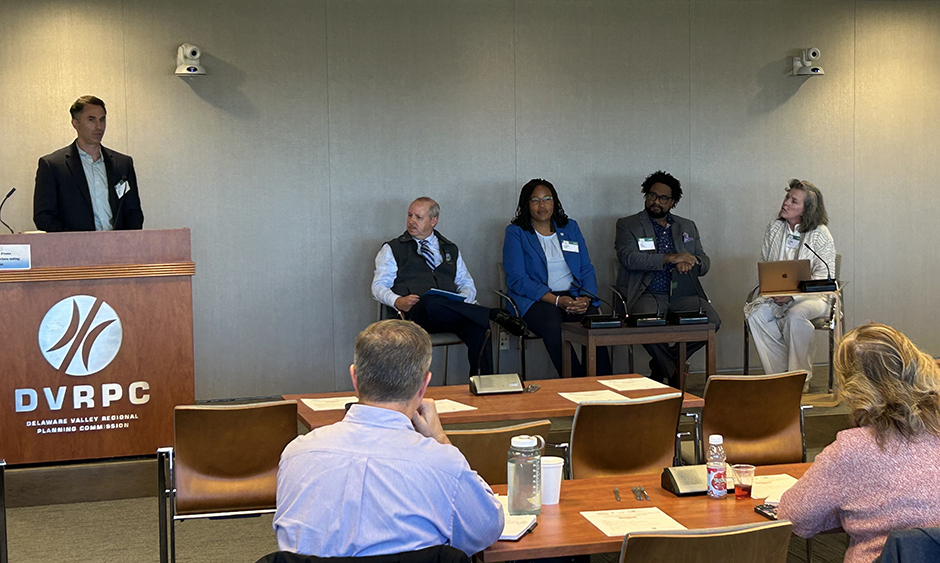
October 25, 2024
The meeting highlighted the severity of the healthcare access crisis caused by hospital closures in the region and emphasized the importance of fostering partnerships between first responders, public health, and planning sectors to address the widespread effects on emergency services, healthcare access, and overall community well-being.
Earlier this month, DVRPC hosted a joint meeting of the Healthy Communities Task Force and the Transportation Operations Task Force on hospital closures in the Delaware Valley region. The meeting opened with welcoming remarks from DVRPC Executive Director Ariella Maron. In her introduction, Maron emphasized DVRPC’s role in regional planning and coordination and noted the significance of the event, which was a necessary response to the increasing challenges posed by hospital closures in the region, specifically concerning healthcare access and the functioning of emergency services.
Dr. Monica Taylor, Chair of the Delaware County Council, followed with an overview of hospital closures on both a national and regional scale. She explained that within Delaware County, two hospitals had closed in the past three years, leaving 85,000 residents without crucial emergency and maternity care. This sudden lack of facilities has placed immense pressure on surrounding hospitals, which are struggling to keep up with the additional patient load, leading to a decline in the quality and timeliness of care. Taylor stressed how these closures disproportionately impact rural and disadvantaged communities, particularly where healthcare options are already limited. By presenting a detailed view of how this crisis is unfolding in Delaware County, she provided a concrete example of how this broader national issue also impacts communities across the DVRPC region.
Following her remarks, Dr. Monica Taylor joined a panel discussion moderated by Dr. Jennifer Taylor, a professor and public health expert from Drexel University. The panel also included Harry Moore, Deputy Director of Chester County Emergency Medical Services (EMS), and Kevin Ressler, President and CEO of The Alliance for Health Equity. The panelists delved into the ripple effects of hospital closures, focusing on how they exacerbate existing challenges within the healthcare system. Moore shared data from Chester County that illustrated the increasing strain on emergency medical services following the closure of Jennersville Hospital, which had served over 8,000 patients. He noted increases in EMS transport times, including time spent offloading patients at remaining hospitals; however, he noted that the increases were not as great as expected (an approximately nine-minute increase).
Ressler added that these closures are particularly harmful to disadvantaged communities, which face barriers not only in accessing emergency services but also in obtaining preventive care. He pointed to systemic issues such as the lack of transportation options, harmful infrastructure designs, and topography that further marginalize these communities. The panelists agreed that addressing the consequences of hospital closures requires collaborative policy solutions. They called for municipalities, healthcare providers, and emergency service agencies to work
together to develop integrated strategies that can mitigate the impact of healthcare facility shutdowns.
The discussion then shifted to possible solutions, with Dr. Jennifer Taylor raising the idea of neighborhood hospitals as a model of care that could fill some of the gaps left by larger hospital closures. While panelists acknowledged that these smaller hospitals can provide relief in certain areas, they expressed concern that neighborhood hospitals are not comprehensive enough to meet the broader healthcare needs of entire communities, particularly in high-demand areas. Dr. Jennifer Taylor also brought up the idea of community paramedicine, with Moore responding that Chester County is working on a community paramedicine pilot. However, many in the room agreed that sustained funding for innovative ideas, like community paramedicine, was an ongoing challenge.
Following the panel discussion, audience members, which included public health officials, EMS providers, and urban planners, participated in a Q&A session. Many attendees shared personal and professional experiences that underscored the challenges brought on by hospital closures. They discussed the need for cross-agency collaborations to address the gaps in services and began considering practical ways to build partnerships between local governments, healthcare providers, and emergency services to improve outcomes
The meeting concluded by highlighting the severity of the healthcare access crisis caused by hospital closures in the region. The event emphasized the importance of fostering partnerships between first responders, public health, and planning sectors to address the widespread effects on emergency services, healthcare access, and overall community well-being. While the session did not present any immediate solutions, it opened the door to further dialogue and collaboration among stakeholders across the region.